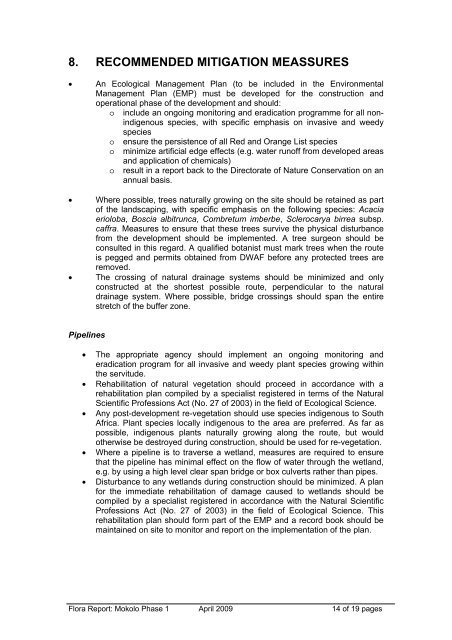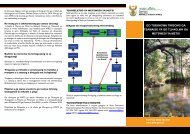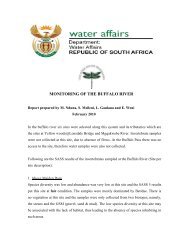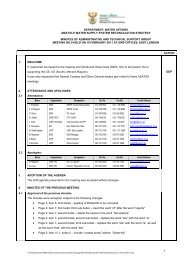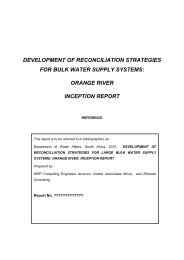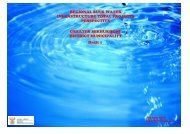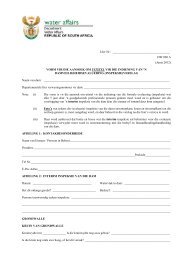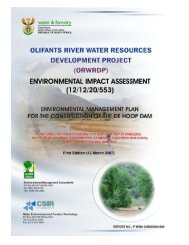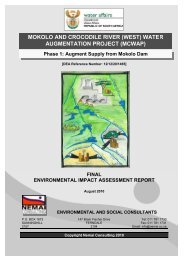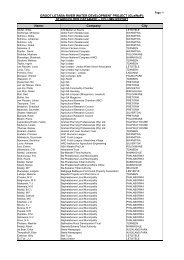Fauna and Flora Specialists - DWA Home Page
Fauna and Flora Specialists - DWA Home Page
Fauna and Flora Specialists - DWA Home Page
Create successful ePaper yourself
Turn your PDF publications into a flip-book with our unique Google optimized e-Paper software.
8. RECOMMENDED MITIGATION MEASSURES<br />
• An Ecological Management Plan (to be included in the Environmental<br />
Management Plan (EMP) must be developed for the construction <strong>and</strong><br />
operational phase of the development <strong>and</strong> should:<br />
o include an ongoing monitoring <strong>and</strong> eradication programme for all nonindigenous<br />
species, with specific emphasis on invasive <strong>and</strong> weedy<br />
species<br />
o ensure the persistence of all Red <strong>and</strong> Orange List species<br />
o minimize artificial edge effects (e.g. water runoff from developed areas<br />
<strong>and</strong> application of chemicals)<br />
o result in a report back to the Directorate of Nature Conservation on an<br />
annual basis.<br />
• Where possible, trees naturally growing on the site should be retained as part<br />
of the l<strong>and</strong>scaping, with specific emphasis on the following species: Acacia<br />
erioloba, Boscia albitrunca, Combretum imberbe, Sclerocarya birrea subsp.<br />
caffra. Measures to ensure that these trees survive the physical disturbance<br />
from the development should be implemented. A tree surgeon should be<br />
consulted in this regard. A qualified botanist must mark trees when the route<br />
is pegged <strong>and</strong> permits obtained from <strong>DWA</strong>F before any protected trees are<br />
removed.<br />
• The crossing of natural drainage systems should be minimized <strong>and</strong> only<br />
constructed at the shortest possible route, perpendicular to the natural<br />
drainage system. Where possible, bridge crossings should span the entire<br />
stretch of the buffer zone.<br />
Pipelines<br />
• The appropriate agency should implement an ongoing monitoring <strong>and</strong><br />
eradication program for all invasive <strong>and</strong> weedy plant species growing within<br />
the servitude.<br />
• Rehabilitation of natural vegetation should proceed in accordance with a<br />
rehabilitation plan compiled by a specialist registered in terms of the Natural<br />
Scientific Professions Act (No. 27 of 2003) in the field of Ecological Science.<br />
• Any post-development re-vegetation should use species indigenous to South<br />
Africa. Plant species locally indigenous to the area are preferred. As far as<br />
possible, indigenous plants naturally growing along the route, but would<br />
otherwise be destroyed during construction, should be used for re-vegetation.<br />
• Where a pipeline is to traverse a wetl<strong>and</strong>, measures are required to ensure<br />
that the pipeline has minimal effect on the flow of water through the wetl<strong>and</strong>,<br />
e.g. by using a high level clear span bridge or box culverts rather than pipes.<br />
• Disturbance to any wetl<strong>and</strong>s during construction should be minimized. A plan<br />
for the immediate rehabilitation of damage caused to wetl<strong>and</strong>s should be<br />
compiled by a specialist registered in accordance with the Natural Scientific<br />
Professions Act (No. 27 of 2003) in the field of Ecological Science. This<br />
rehabilitation plan should form part of the EMP <strong>and</strong> a record book should be<br />
maintained on site to monitor <strong>and</strong> report on the implementation of the plan.<br />
<strong>Flora</strong> Report: Mokolo Phase 1 April 2009 14 of 19 pages


